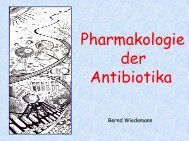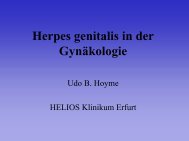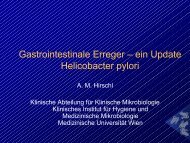CMV Pneumonie nach Transplantation: Aktuelle Prophylaxe und ...
CMV Pneumonie nach Transplantation: Aktuelle Prophylaxe und ...
CMV Pneumonie nach Transplantation: Aktuelle Prophylaxe und ...
Sie wollen auch ein ePaper? Erhöhen Sie die Reichweite Ihrer Titel.
YUMPU macht aus Druck-PDFs automatisch weboptimierte ePaper, die Google liebt.
<strong>CMV</strong> <strong>Pneumonie</strong> <strong>nach</strong> <strong>Transplantation</strong>:<br />
<strong>Aktuelle</strong> <strong>Prophylaxe</strong> <strong>und</strong><br />
Therapiestrategien<br />
Susanna Prösch, Institut für Virologie<br />
Charité - Universitätsmedizin Berlin
Latenz<br />
H<strong>CMV</strong> (Re)aktivierung<br />
Immunompetenz<br />
Eliminierung<br />
der InfeKtion<br />
H<strong>CMV</strong> Antigenämie<br />
Partielle<br />
Immunsuppression<br />
Immunopathologie<br />
(e.g. Rejektion)<br />
Immunsuppression<br />
H<strong>CMV</strong> Disease
H<strong>CMV</strong> - Pathogenese<br />
Latenz<br />
Inflammation<br />
stress<br />
produktive Infektion<br />
Lunge<br />
Darm<br />
Leber<br />
Niere<br />
ZNS, Auge<br />
Immunmodulation<br />
TNFα, IFNγ, IL-6, IL-8, ICAM-1,<br />
RANTES, VCAM-1<br />
Virus replication<br />
Immunantwort
<strong>CMV</strong> <strong>Pneumonie</strong> <strong>nach</strong> allogener<br />
Knochenmarktransplantation<br />
vor Therapie<br />
<strong>nach</strong> Therapie
Pathogenese der <strong>CMV</strong> <strong>Pneumonie</strong><br />
Targetzellen : Alveolarepithel (Typ II Zellen)<br />
Lungenendothel<br />
Fibroblasten<br />
Zellen der glatten Muskulatur<br />
Makrophagen<br />
Aktivierung des Endothels durch erhöhte Expression<br />
von ICAM-1, VCAM-1, Willebrandt Faktor
Lungenepithel<br />
Mesenchym<br />
<strong>CMV</strong>-infizierte Alveolarzelle<br />
Endothel<br />
<strong>CMV</strong>-infizierte Interstitialzelle<br />
<strong>CMV</strong>-Infizierte Endothelzelle<br />
Makrophagen<br />
Sinzger et al. 1995
Pathogenese der <strong>CMV</strong> <strong>Pneumonie</strong><br />
Cytopathogenese Immunpathogenese<br />
Häufiger bei Primärinfektion<br />
Hohe Viruslast in der BAL<br />
ATG, OKT3, Glukokortikoide =<br />
Risikofaktoren<br />
sympt. <strong>Pneumonie</strong> nur in<br />
immunsupprimierten Mäusen<br />
Infiltration von Leukozyten<br />
Induktion von Endothelzell-spez. Ak<br />
bei HIV-Patienten <strong>CMV</strong> <strong>Pneumonie</strong><br />
nur bei hoher CD4+ Zahl<br />
<strong>CMV</strong> <strong>Pneumonie</strong> in Mäusen nur bei<br />
Aktivierung des Immunsystems<br />
Effekt der antiviralen Therapie gering<br />
Cytokine !
Risikofaktoren für eine <strong>CMV</strong>-<br />
Infektion/Erkrankung in Transplantatempfängern<br />
• H<strong>CMV</strong>-Serostatus von Rezipient <strong>und</strong> Donor<br />
D+/R- > D+/R+ ≥ D-/R+ > D-/R-<br />
• Immunsuppression<br />
• Transplantiertes Organ/e<br />
• Alter des Donors<br />
• HLA-Match, Verwandtschaft, GVHD<br />
• <strong>CMV</strong>-spez. Immunrekonstitution<br />
• (Super)Infektionen
Häufigkeit der <strong>CMV</strong> <strong>Pneumonie</strong><br />
NiereTx gering bei preemptiver o. prophylaktischer Therapie<br />
LeberTx 12 % (≤ 38 Tage pTx, 1 Jahres Lethalität 85 % vs. 17 %)<br />
LungenTx 36-59 % 90-100 % <strong>Pneumonie</strong> in D+R<br />
60 % in D+R+ <strong>und</strong> D-R+<br />
HerzTx ≤ 20 % (Lethalität 44 %)<br />
BMTx/SCTx allogen 5-14 % (Lethalität ≤76 %, Infektionen 80%)<br />
autolog 1,2-8,6 % (Infektionen 15-60%)
Diagnose <strong>CMV</strong>-<strong>Pneumonie</strong><br />
Klinische Symptome:<br />
Fieber<br />
Dyspnoe<br />
Röntgenolog. Diagnostik: diffuse Infiltrate<br />
Virologische Diagnostik: Nachweis von <strong>CMV</strong> in BAL<br />
Antigen (Immuncytologie)<br />
DNA (qual./quantitativ)<br />
Viruskultur ?<br />
Nachweis von <strong>CMV</strong> im Blut<br />
Antigenämie<br />
DNA <strong>und</strong>/oder RNA (qual./quantitativ)<br />
Histologisch: Lungenbiopsie (H&E Färbung; immunhistologischer Nachweis)<br />
Serologie: IgM; IgG in der BAL selten ????
Antivirale<br />
<strong>Prophylaxe</strong> <strong>und</strong> Therapie
Anti-<strong>CMV</strong> Therapeutika<br />
Ganciclovir<br />
(Cymeven)<br />
Valganciclovir<br />
(Valcyte)<br />
Foscarnet<br />
(Foscavir)
Anti-<strong>CMV</strong> Therapie<br />
Immunglobulin Monotherapie zur <strong>Prophylaxe</strong>???<br />
Kombinationstherapie<br />
Acyclovir /Valacyclovir Monotherapie zur<br />
zur <strong>Prophylaxe</strong>;Kombinationstherapie<br />
Cidofovir
Therapie<br />
• prophylaktisch<br />
• preemptiv<br />
• klinisch symptomatisch
Therapieschemata<br />
<strong>Prophylaxe</strong><br />
i.v. GCV <strong>und</strong>/oder oralValGCV <strong>und</strong>/oder FC 1-3 Monate (Herz, Lunge, BMT)<br />
5 mg /kg 2xtägl. 2-3 Wochen; 5 Tage 5 mg/kg tägl. 3-4 Wochen; 90 mg/kg 2xtägl. 5 Tage 90 mg/kg 3xwöchentlich<br />
hochdosiert ACV <strong>und</strong>/oder Immunglobuline (Niere; Leber)<br />
500 mg/m2 3xtägl.<br />
Preemptive Therapie<br />
i.v. GCV <strong>und</strong>/oder oralValGCV oder Foscarnet (4-12 Wochen)<br />
5mg/kg 2xtägl 2Wochen (6mg/kg/tägl.); 60 mg/kg 2xtägl. 90 mg/kg tägl<br />
Symptomatische Therapie<br />
i.v. GCV <strong>und</strong>/oder oralValGCV oder Foscarnet (oralGCV ???)<br />
(wie preemptive Therapie 3-4 Wochen Induktionstherapie + 4 Wochen Erhaltungstherapie;<br />
bei <strong>Pneumonie</strong> plus Immunglobulin)<br />
<strong>nach</strong> Rubin, 2004; Ljungman et al. 2004 EBMT
Nachweis der H<strong>CMV</strong> Antigenämie<br />
pp65 Antigenämie in PMN<br />
≥ 2-20 pos. Zellen/200.000 PMN<br />
Nachweis von mehreren Antigenen (IE,<br />
pp65, p105) mittels APAAP in PBMC<br />
<strong>und</strong> BAL<br />
≥ 60 pos. Zellen / 200.000 PBMC<br />
≥ 1-2 pos. Zellen/ 1000 BAL Makrophagen
Korrelation von <strong>CMV</strong> Erkrankung <strong>und</strong><br />
Viruslast bei KMTx Patienten<br />
aus Leruz-Ville et al. 2003
Korrelation immunhistologischer Bef<strong>und</strong>e <strong>und</strong> Viral Load in<br />
BAL <strong>und</strong> Blut<br />
IHC BAL<br />
Blut<br />
<strong>CMV</strong> viral load <strong>CMV</strong> Viral load<br />
MW Min - Max MW Min - Max<br />
negative 0 0-193.442 0 0- 40.587<br />
n=26<br />
Atypical 47.678 2.791-312.175 1.176 0-14.019<br />
n=8<br />
Typical 1.548.827 555.505-2.450.702 189.013 0-1.491.020<br />
n=5<br />
Aus Chemaly et al., 2004
Patient with acute myeloic leukemia after BMT<br />
BMT <strong>CMV</strong> marker in follow-up<br />
TN<br />
GvHD of the skin,<br />
steroid therapy<br />
BMT<br />
GvHD<br />
gastrointestinal,<br />
hepatitis?,<br />
ALT elevation<br />
GvHD<br />
intestinal,<br />
diarrhea<br />
ALT, Bili elevation,<br />
cholestase,<br />
hemorrhagic ALT elevation<br />
diarrhea<br />
dyspnea<br />
Herpes<br />
simplex<br />
fever<br />
<strong>CMV</strong> pneumonia<br />
PcP<br />
Ganciclovir<br />
10 11 12 1 2 3 4 5 6 7 8 9 10 11<br />
1997 1998<br />
virusisolation<br />
<strong>CMV</strong>-IgM<br />
pp65 antigen<br />
DNA (quant)<br />
pp67 mRNA<br />
DNA (in-house PCR)<br />
months<br />
<strong>CMV</strong> D+ R+<br />
i.v.<br />
per os<br />
pos<br />
neg<br />
DNA quant. (Tsd. cop/ml)<br />
30<br />
20<br />
10<br />
40<br />
30<br />
20<br />
10<br />
10 11 12 1 2 3 4 5 6 7 8 9 10 11<br />
1997 1998<br />
pp65 Antigen<br />
(/200000 PBL)<br />
months
pre-emptive Therapie<br />
prophylaktische Therapie<br />
•Senkung der Inzidenz von H<strong>CMV</strong>-<br />
Erkrankungen > 20%
Therapieschemata<br />
<strong>Prophylaxe</strong><br />
i.v. GCV <strong>und</strong>/oder oralValGCV <strong>und</strong>/oder FC 1-3 Monate (Herz, Lunge, BMT)<br />
5 mg /kg 2xtägl. 2-3 Wochen; 5 Tage 5 mg/kg tägl. 3-4 Wochen; 90 mg/kg 2xtägl. 5 Tage 90 mg/kg 3xwöchentlich<br />
hochdosiert ACV <strong>und</strong>/oder Immunglobuline (Niere; Leber)<br />
500 mg/m2 3xtägl.<br />
Preemptive Therapie<br />
i.v. GCV <strong>und</strong>/oder oralValGCV oder Foscarnet (4-12 Wochen)<br />
5mg/kg 2xtägl 2Wochen (6mg/kg/tägl.); 60 mg/kg 2xtägl. 90 mg/kg tägl<br />
Symptomatische Therapie<br />
i.v. GCV <strong>und</strong>/oder oralValGCV oder Foscarnet (oralGCV ???)<br />
(wie preemptive Therapie 3-4 Wochen Induktionstherapie + 4 Wochen Erhaltungstherapie;<br />
bei <strong>Pneumonie</strong> plus Immunglobulin)<br />
<strong>nach</strong> Rubin, 2004; Ljungman et al. 2004 EBMT
Studie/ Author Transplant Inzidenz von <strong>CMV</strong><br />
<strong>CMV</strong> Therapie<br />
Pre-emptive GCV<br />
Erkrankungen<br />
Placebo<br />
Inzidenz von<br />
Antigenämie<br />
Paya et al. 2002<br />
LeTx<br />
0 %<br />
12 %<br />
Koetz et al. 2001<br />
LeTx, NTx (N=50)<br />
0 % (n=5)<br />
100 % (n=7)<br />
12/50 (24 %)<br />
Rayes et al. 2001<br />
LeTx (N=372)<br />
10 % (n=30)<br />
20 % (n=30)<br />
88/372 (24 %)<br />
Khouri et al. 2003<br />
allo-PBSCTx<br />
7 %<br />
75/165 (45%)<br />
Casillo et al. 2004<br />
HTx (N=127)<br />
5 %<br />
18 %<br />
61 %<br />
Harland et al.<br />
SKPTx<br />
Prophylaktisch GCV<br />
25 %<br />
56 %<br />
Kotzi et al.<br />
SKPTx<br />
SKPTx + ATG<br />
35 %<br />
14 %<br />
74 %<br />
70 %<br />
Oldakowska et<br />
al. 2004<br />
LuTx<br />
10 %<br />
30 %
iv GCV <strong>Prophylaxe</strong> in Lungentransplantation<br />
Author N <strong>CMV</strong> <strong>Prophylaxe</strong> Outcome Onset of Dis.<br />
Duncan et al. 92 13 GCViv x 3 W<br />
ACV x 2 W<br />
38 % Infektion 72 Tage <strong>nach</strong> Tx<br />
15 % Disease<br />
Duncan et al 94 13 GCViv x 90 Tage 58 % Infektion 268<br />
Kelly et al. 94 21 GCViv x 6 Wochen 81 % Infektion 145<br />
38 % Disease<br />
Soghikian et al. 96 52 GCViv x 5 Wochen 86 % Infektion 85<br />
55 % Disease<br />
Hertz et al. 98 35 GCViv 2/Tag x 90d 51 % Disease<br />
37 GCV x 3 Wochen 30 % Disease<br />
aus Zamora, 2004
Effektivität pre-emptiver Therapy<br />
Casillo et al.,2004<br />
127 HTx Patienten<br />
pp65 negativ<br />
pp65 positiv<br />
47 (39 %) 80 (61%)<br />
< cutt-off > cut-off<br />
32 (40 %) 48 (60 %)<br />
keine Erkrankungen 5 Erkrankungen<br />
(4.7% vs. 18 % ohne Therapie)<br />
1/5 GCV Resistenz
GCV-Resistenz<br />
Inzidenz: 3-16 % LuTx (Erice, 1999)<br />
5,2 % LuTx (Kruger et al. 1999)<br />
5,0 % NTx/LeTx (Turgeon et al.2000)<br />
Riskofaktoren: Therapielänge<br />
oralGCV<br />
lang anhaltende Antigenämie bei hoher Immunsuppression<br />
Alternativtherapien: Foscarnet<br />
Cidofovir
Zusammenfassung<br />
Primärziel - Verhinderung der <strong>CMV</strong>-<strong>Pneumonie</strong> durch<br />
prophylaktische oder preemptive antivirale Therapie<br />
preemptive Therapie unter Einbeziehung der BAL-<br />
Diagnostik auch für Hochrisikogruppen empfehlenswert<br />
antivirale Therapie mit GCV, ValGCV, Foscarnet<br />
symptomatische Therapie limitiert
Patienten <strong>nach</strong><br />
Organtransplantation<br />
Patienten mit<br />
HIV Infektion<br />
Pränatale <strong>CMV</strong>-<br />
Infektion<br />
Patienten<br />
mit Sepsis<br />
Stillende Mütter<br />
Frühgeborene<br />
Patienten mit<br />
Myokardinfarkt<br />
ältere<br />
Patienten<br />
Patienten mit<br />
schwerer<br />
Psoriasis
Humanes Cytomegalievirus (HHV 5)


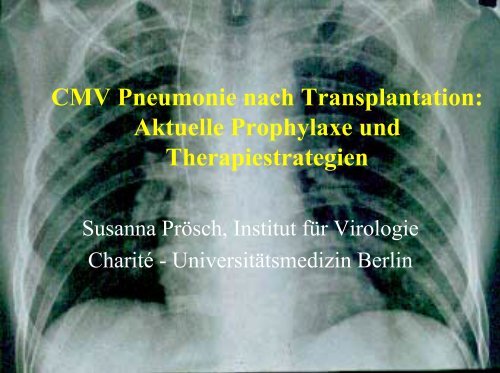
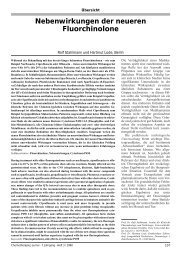
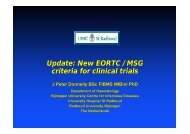
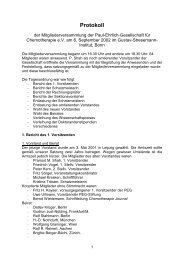
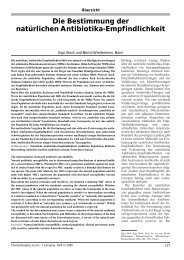

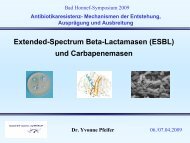
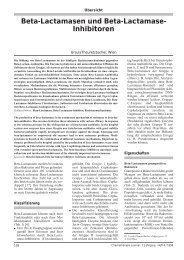
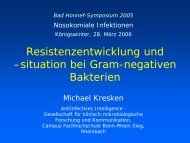

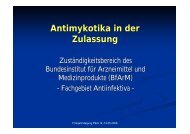
![Willinger.ppt [Schreibgeschützt]](https://img.yumpu.com/25098535/1/190x135/willingerppt-schreibgescha-1-4-tzt.jpg?quality=85)
